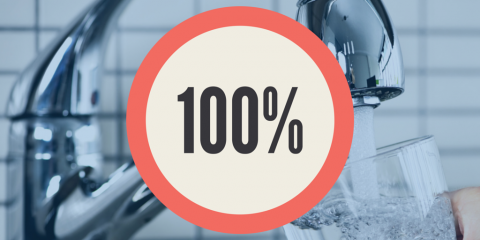
Did anyone notice the release of the National Performance Report (NPR) for urban water utilities in Australia a few weeks ago? You’ll be forgiven for missing it, coming out just as everyone was preparing to head to Adelaide for Ozwater'15. There are some interesting and pleasing trends coming through, one of the most pleasing is to see each year a gradual increase in utilities achieving 100% compliance with the microbial health target in the Australian Drinking Water Guidelines. The dedication of urban water industry professionals in delivering clean safe drinking water for our customers, even in the most challenging of environments and circumstances, is one of the most significant unsung stories in making our communities healthy and liveable.
Another question for you then: do you know what 100% compliance with the microbial health target actually means? We do have a blind spot in that whilst the target is admirable, measuring E. coli at customers taps is one of those lag indicators to make you just a little nervous. As evidence from the NPR shows, our drinking water is extremely good quality and reliably so. But what happens if you do pick up a positive? Have you missed an event? Is it a distribution and network issue or way back in your catchments or treatment?
Right now the National Health and Medical Research Council (NH&MRC) is looking at the potential implementation of Health Based Targets (HBTs). I won’t drag you through the detail of what an HBT is but simply put it means drinking water needs to achieve a target quality based on rates of illness in the community (not the presence or absence of pathogens in tap water).
These rates of illness are albeit practically at an immeasurable level. This should provide great confidence to consumers but there are some challenges in cost benefit analysis – more on that later.
What advantage might that be over the current system? There is plenty on the plus side: a HBT is desirable because it indirectly sets the minimum requirements for water treatment processes and operation. It also provides a framework for understanding the risks of your catchments through sanitary surveys. This overcomes a gap in the current ADWG which has resulted in inconsistent approaches to water treatment assessment and outcomes across Australia.
Professionals in the WSAA Water Quality Network have been doing the background work to understand what the implementation of HBTs might mean for utilities. Led by one of our best and most experienced water quality managers, Richard Walker from Water Corporation in Perth, WSAA has developed a manual for water utilities to implement HBTs. This was tested in a hands on workshop at Ozwater a couple of weeks ago with very positive feedback. Even if for some reason HBTs aren’t implemented in Australia it’s just good practice.
That might be good for the big end of town I heard you say – what about the smaller regionals with limited resources? Concerns about costs and regulation have been assessed, and it is feasible to implement an HBT even at those small delivery systems. The important point from our assessment is that there will be some costs but no more than required to fully implement the current ADWG. The approach developed by WSAA is pragmatic, can be implemented by utility staff and has support from NH&MRC. Projects managed under the HBT process have the advantage they can be prioritised using a consistent risk based methodology. Since most schemes are operating in the “safe” part of the continuum this means (for the most part) assimilation of projects into capital programs over a five to ten year period will avoid unreasonable cost increases for customers.
Another issue we have grappled with of course is how well consumers, our customers, engage us on water quality. Usually it’s when they have a complaint or a major event occurs, but on the whole many take for granted the healthy water delivered inside their homes 24/7. There is no doubt we are moving to an area of public health protection that will be very, very difficult to measure and if we can’t do that, how do we engage our customers on the costs and benefits? If customers in some areas are happy with their existing supply, what’s the conversation we will have with them about achieving the new target? It will challenge us, and the broader industry including regulators, as we move towards our vision of ‘Customer driven, enriching life’.
This all might sound like we are the lead cheerleaders on HBTs but it’s actually a far bigger issue, and in fact not even the call of water utilities. However, adopting the WSAA HBT approach provides ongoing confidence for WSAA members that their schemes are continuously delivering safe drinking water and their duty of care to customers has been met. No more nervous waits for the customer water quality test – utilities will know how well they are managing their water quality before it enters the network. The achievement of a consistent, national approach to something as fundamental as adequate water treatment and healthy water quality for our customers is finally within reach.
